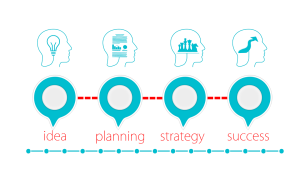Many people go through the motions of their daily work only occasionally giving thought to how their unique strengths factor into their work performance and job fit. As a result, these individuals may flounder in their duties, despite their hard work. Demoralized and frustrated, these employees may blame themselves for “not getting it right” when in reality, they are highly capable individuals who are simply in a role that does not align with their strengths and talents. Alternatively, they may excel at the job-specific aspects of their work but remain unaware of a weakness, such as poor time management, that is hampering their progress. Unaware of their weakness, they struggle to keep up with colleagues and advance in their careers. Meanwhile, individuals who possess insight into their unique strengths and weaknesses are well-positioned to experience greater satisfaction within their careers (view more data and stats for employee satisfaction) as they seek out types of work and roles where they are most likely to flourish.
Understanding your work-related strengths and how to use them, as well as work-related weaknesses, can help you begin to build your personal ‘brand,” the set of traits that make you an excellent hire for work that energizes you! There are several ways to begin the process of discovering your strengths. Often, however, we mistake our strengths for the type of work that we currently do or the work that others expect us to excel in. To overcome these potential biases, strengths assessments are designed to objectively measure an individual’s unique strengths and tendencies. For example, the HIGH5 strengths assessment provides an in-depth, personalized analysis of your top five talents and potential areas for improvement. The assessment takes about 20 minutes to complete, and there is no cost. Keep reading for practical methods to implement knowledge of your strengths and weaknesses into your professional life.
28 examples of employee strengths
Below are twenty-eight strengths that can enhance performance in any given workplace:
- Communication
- Problem-solving
- Emotional intelligence
- Motivation
- Leadership
- Resilience
- Flexibility
- Confidence
- Optimism
- Adaptability
- Dependability
- Organization
- Teamwork
- Time management
- Trustworthiness
- Accountability
- Critical thinking
- Collaboration
- Empathy
- Self-discipline
- Detail-orientation
- Initiative
- Openness to experience
- Friendliness
- Integrity
- Dedication
- Creativity
- Diligence
Communication
Effectively conveying information and ideas, ensuring clarity and understanding.. Good communicators can adapt their message to their audience, choose appropriate communication methods according to the subject, and are adept at speaking, writing, and listening, and build relationships over time.
Problem-solving
Identifying issues and implementing solutions efficiently and effectively. Strong problem solvers approach challenges methodically and creatively, often anticipating potential obstacles before they arise.
Emotional intelligence
Recognizing and managing one’s own emotions and those of others to foster positive relationships. This strength supports conflict resolution and leadership and is essential to building an maintaining a positive work environment.
Motivation
Demonstrating enthusiasm and drive to achieve goals and exceed expectations. Motivated individuals often inspire others and maintain high levels of productivity and morale.
Leadership
Guiding and inspiring others towards the attainment of a common goal with vision and integrity. Effective leaders build trust, communicate a clear vision, and empower their team members.
Resilience
Recovering quickly from setbacks and maintaining focus and determination. Resilient employees handle stress well, work through setbacks, and remain committed in the face of adversity.
Flexibility
Adjusting to new conditions and handling multiple tasks with ease. Flexible individuals are open to change and can pivot quickly when priorities or available resources shift.
Confidence
Exhibiting self-assurance and belief in one’s abilities. Confident employees are more likely to take on challenges and make decisions with conviction.
Optimism
Maintaining a positive outlook and expecting favorable outcomes. Optimism can boost morale and create a hopeful atmosphere, even during difficult times.
Adaptability
Adjusting effectively to changing environments and situations. Adaptable employees thrive in dynamic settings and are quick to learn new skills.
Dependability
Being reliable and consistently meeting commitments and responsibilities. Dependable individuals build trust through their reliability and punctuality.
Organization
Managing tasks and resources efficiently to achieve goals. Organizational skills help in maintaining order, prioritizing tasks, and ensuring deadlines are met.
Teamwork
Collaborating effectively with others to achieve common objectives. Team players communicate well, support their colleagues, and contribute to a cohesive team environment.
Time management
Prioritizing tasks and managing time efficiently to meet deadlines. Good time managers use tools and techniques to maximize productivity and minimize procrastination.
Trustworthiness
Being honest and reliable, earning the confidence of others. Trustworthy individuals uphold integrity and are seen as dependable by their peers and supervisors.
Accountability
Taking responsibility for one’s actions and outcomes. Accountable employees own their work, learn from mistakes, and are committed to continuous improvement.
Critical thinking
Analyzing situations logically to make informed decisions. Critical thinkers evaluate evidence, consider alternatives, and come to reasoned conclusions.
Collaboration
Working well with others, seeking input, and sharing knowledge to achieve mutual goals. Collaborative employees foster a cooperative spirit and leverage diverse perspectives for better results.
Empathy
Understanding the feelings of others to build strong relationships. Empathetic individuals create supportive environments and improve team cohesion.
Self-discipline
Maintaining focus and control to achieve long-term goals. Disciplined employees are consistent in their efforts and maintain high standards in their work.
Detail-orientation
Paying close attention to all aspects of a task to ensure accuracy. Detail-oriented individuals catch mistakes others might miss and ensure high-quality outputs.
Initiative
Taking the initiative to anticipate and address potential issues. Proactive employees solve problems before they escalate and contribute to smoother operations.
Openness to experience
Being willing to try new things and consider different perspectives. Open individuals are innovative and embrace learning opportunities.
Friendliness
Being approachable and creating a welcoming environment for others. Friendly employees build strong rapport with colleagues and contribute to a positive workplace culture.

Integrity
Adhering to strong moral and ethical principles. Employees with integrity earn respect and trust through their honest and ethical behavior.
Dedication
Committing fully to tasks and goals, often performing above and beyond expectations. Dedicated individuals show perseverance and a strong work ethic.
Creativity
Generating innovative ideas and solutions to problems. Creative employees bring fresh perspectives and can transform challenges into opportunities.
Diligence
Putting in a consistent and earnest effort to achieve high standards. Diligent workers are thorough and persistent, ensuring that tasks are completed efficiently and effectively.
The list above highlights some of the key strengths that can contribute to an employee’s effectiveness and the organization’s success. Identifying the strengths you possess in abundance can help you seek out roles where you are most likely to flourish. For example, if you excel in emotional intelligence, you may decide to seek out roles that rely on these strengths. Human service fields in particular rely upon professionals with a “high EQ” who can deftly operate in emotionally-charged situations. Similarly, individuals with high organizational skills are likely to excel in operations and administrative roles. The HIGH5 strengths assessment scientifically evaluates your unique employability strengths and provides you with actionable strategies to capitalize on your strengths within your career. If you have ever wondered if you are on the right track in your career, taking the assessment can provide you with affirmation that you are in the right place or insight to help you change course.
Pro Tip From HIGH5
Reflect on the list of strengths and identify 3-5 that resonate most with you. Seek feedback from colleagues, and managers, or take the HIGH5 assessment. What themes do you notice? What strenths, tendencies, and terms seem to rise to the top? Once you understand your top strengths, explore ways to leverage them more intentionally in your current role or future career opportunities.
How to highlight employee strengths and skills in a job interview?
Familiarity with your unique strengths and skills can not only help you seek the role that’s right for you, but also land the job! Candidates who can speak clearly and confidently about their strengths, the value that they offer, and how their strengths align with the opportunity stand out to interviewers. Highlight your strengths in your next job interview by following the steps below:
- Identify key strengths to discuss with your interviewer: Before the interview, review the job description and identify the skills that are most relevant to the position. Think about how you will elaborate on how your strengths relate to this skill. For example, if you are applying for a marketing position, highlight examples of how you have demonstrated excellent communication skills in your academic or professional career.
- Prepare examples: Think of specific examples from your past experiences that demonstrate your strengths. Use the STAR method (Situation, Task, Action, Result) to structure your answers clearly and concisely. To use the STAR method, begin with a brief explanation of the situation (“S”). For example, you might state that you were hired to lead a newly developed department. Next, describe the task (“T”) you were assigned. Perhaps as a new department manager, one of your tasks was to design an onboarding plan for new employees. Next, describe the action you took (“A”). You might elaborate on how you designed an onboarding and training curriculum for new employees. Lastly, describe the result (“R”). Here, you will describe the outcome of your action. For example, your onboarding and training program may have allowed new hires to begin functioning within 75% of their total job duties within their first month of employment. Don’t forget to highlight the strength (perhaps initiative!) that guided this process. Continuing with our previous example, you may describe how your leadership strengths supported your work in this example.
- Align with company goals: Research the company’s values and goals, and tailor your responses to show how your strengths align with and can contribute to these objectives.
- Be honest and authentic: Be genuine about your strengths and how you’ve applied them. Authenticity builds trust and demonstrates self-awareness.
- Practice describing your strengths: Practice articulating your strengths confidently and succinctly. This will help you present yourself as prepared and professional during the interview.
How to highlight employee strengths and skills in a resume/CV?
Communicating your strengths and skills effectively in a resume or CV can help you stand out to potential employers – and get that job interview! Consider the following tips for creating a resume that highlights your best strengths.
- Tailor your strengths and skills to the job description: This may be the most important action you can take to maximize your chances of being invited to participate in an interview. Emphasize the strengths and skills that are most relevant to the position.
- Use a skills section: Create a dedicated section for skills, listing your key abilities in a clear, bullet-point format. This makes it easy for hiring managers to quickly identify your qualifications.
- Incorporate your strengths into your work experience: Use action verbs and quantify achievements to demonstrate how you applied strengths in past roles.
- Include relevant keywords: Use industry-specific keywords that match the job description. This not only highlights your skills but also helps your resume pass through Applicant Tracking Systems (ATS).
- Showcase strengths with examples: Provide specific examples of how you used your strengths to achieve results. Mention projects, responsibilities, and accomplishments that demonstrate your capabilities.
How to identify employee strengths and weaknesses?
Identifying the strengths and weaknesses of employees is essential for maximizing team performance and individual growth. These six steps will help you identify the strengths and weaknesses of employees.
- Observe performance: Note themes and patterns in employee performance that reveal the types of tasks that an employee completes with ease and excellence. You may also notice patterns in their work that reveal tasks that an employee struggles to complete on time at a high level of quality. When an employee struggles to complete a task or a type of task, consider the possibility that poor employee-task fit may be the underlying cause and not a lack of effort. In these cases, you may consider re-training, additional support, or re-allocation of tasks.
- Seek feedback: Collect feedback from colleagues, supervisors, and clients about an employee’s performance. Multiple perspectives can provide a well-rounded view of the strengths and weaknesses that exist across a team
- Conduct assessments: Utilize formal assessments such as the HIGH5 strengths assessment to gain insights into employees’ innate talents and abilities. The HIGH5 strengths assessment offers a version specifically for teams!
- Evaluate past successes: Review past projects and accomplishments to identify the areas in which employees have consistently excelled. Look for key skills and behaviors that contributed to their success.
- Engage in conversations: Have one-on-one discussions with employees about their interests, career aspirations, and areas where they feel most confident. Use this knowledge to assign tasks and team roles according to what each employee does best.
- Create opportunities: Provide diverse opportunities for employees to take on different roles or projects. Novel experiences often uncover hidden strengths and new areas of potential.
How to develop employee strengths further?
Continuous development of employee strengths contributes to ongoing organizational success. Employees who are supported in the continual development of their strengths and interests experience higher engagement with their work and motivation. As a result, these employees are less likely to experience turnover and more likely to perform at continually higher levels of quality [1]. These strategies can help develop employee strengths organization-wide.
- Provide training and professional development opportunities: Training programs, workshops, and courses deepen expertise and allow employees to discover new strengths.
- Assign projects that present a challenge slightly beyond the employee’s current skill level: Research by psychologist Mihaly Csikszentmihalyi revealed that individuals experience a heightened state of absorption and concentration or “flow” when engaged in a task that is slightly more difficult than their current skill level [2]. As the individual engages with the task, their skill level will grow to match the challenge. The key is to not assign projects that are too far beyond the individual’s skill as this will result in frustration, or to assign projects that are below the individual’s skill level, which will result in boredom and stagnation.
- Offer mentorship: Pair employees with mentors who can provide guidance, share experiences, and support employees in the setting and attainment of goals related to their unique strengths.
- Encourage continuous learning: Promote a culture of continuous improvement by encouraging employees to pursue certifications, attend conferences, and engage in self-directed learning. Consider tuition assistance or reimbursement for professional development as an employee benefit.
- Help employees set clear goals: Work with employees to establish specific, achievable goals that align with their strengths. Regularly review progress and provide constructive feedback to keep employees accountable and on track.
- Recognize and reward growth: Acknowledge and reward employees for using their strengths effectively. This positive reinforcement encourages them to continue developing their skills.
Pro Tip From HIGH5
Schedule a check-in with your manager to discuss your perceived strengths and areas for improvement. Additionally, consider taking the HIGH5 assessment to gain an objective perspective on your talents and blindspots. This self-awareness can inform your professional development goals and career planning.
How to turn your weaknesses into strengths?
Transforming weaknesses into strengths requires a proactive and strategic approach. Here’s how to do it:
- Self-assessment: Honestly assess your weaknesses to understand their root causes. Use tools like self-assessments and feedback from others to gain clarity.
- Set specific goals: Define clear, achievable goals for improvement. Break them down into manageable steps to track progress over time.
- Seek training and education: Enroll in courses, workshops, or seminars to build skills in areas of weakness. Continuous learning is key to overcoming deficiencies.
- Leverage strengths: Use your existing strengths to compensate for weaknesses while you work on improving them. For example, if you struggle with time management but are detail-oriented, create detailed schedules to stay on track.
- Practice regularly: Consistent practice and application of new skills are essential. Integrate these practices into your daily routine to develop competence and confidence.
- Seek feedback and adjust: Regularly seek feedback from trusted sources to monitor your progress and make necessary adjustments. Constructive criticism helps refine your approach.
Pro Tip From HIGH5
Observe high-performing colleagues or teammates and analyze how their unique strengths contribute to their success. Consider taking the HIGH5 assessment as a team to gain insights into each member’s strengths and how you can collaborate more effectively by playing to one another’s abilities.
How should I address weaknesses in an annual performance review?
An honest and objective employee performance review should include a discussion of both strengths and reflection on successes, as well as weaknesses and areas where performance could be improved. When addressing weaknesses in a performance review, it’s important to be honest and supportive.
- Be specific: Identify areas for improvement with specific examples from the recent past. Avoid vague statements or unsubstantiated judgments.
- Develop a plan: Create an action plan to help ensure improvement. The plan should include specific actions you will take to ensure success and a future time during which you will assess your progress with a supervisor.
- Keep it professional: Focus on professional weaknesses that are relevant to the job. Keep in mind that the goal of a performance review is to improve work performance.
6 employee weaknesses explained
- Procrastination
- Inability to delegate
- Lack of confidence
- Poor communication
- Passivity
- Disorganization
Procrastination
Employees who delay tasks until the last minute often perform lower-quality work and strain team confidence. Procrastination may result from poor employee time management, but could also indicate a need for training and support. Employees may be more likely to delay work that is confusing, intimidating, or not matched to their skill set.
Inability to delegate
Employees who take ownership of their work are valuable to the team, but when “owning” one’s work results in an overwhelming workload or inefficiencies, employees must be able to delegate. Often employees who struggle to delegate lack trust in teammates.
Lack of confidence
Employees who doubt their abilities are less likely to take on new challenges, pursue opportunities, share ideas, and thrive through change.
Poor communication
Employees who are poor communicators fail to convey information in a clear, timely fashion, leading to miscommunications and errors. Alternatively, poor communicators may also communicate in a way that is inappropriate for the communication method or situation.
Passivity
Passive employees avoid taking initiative and making decisions. Passivity often results in over-reliance on direction from a supervisor.
Disorganization
Disorganized employees lack structure in managing tasks and time, leading to missed deadlines and inefficiencies. Disorganization can result in a chaotic workflow and overlooked responsibilities.
Pro Tip From HIGH5
Make a habit of actively seeking feedback from various sources (managers, peers, direct reports) on your strengths and areas for development. Remain open-minded and view this as an opportunity for growth. Complement this feedback with insights from the HIGH5 assessment to develop a well-rounded understanding of your abilities.
Conclusion
Understanding your strengths and weaknesses enables you to capitalize on what you are good at, while opening your eyes to areas for improvement, or roles that may not be a good long-term fit. Being able to articulate your strengths and weaknesses demonstrates self-awareness, making you a more attractive job candidate with an orientation toward ongoing professional growth.
References:
- Giroux, C. (1960). The Motivation to work, by F. Herzberg, B. Mausner and B.-C. Snyderman, John Wiley & Sons, New York, John Wiley & Sons, 1959. Relations Industrielles-industrial Relations, 15, 275-276. https://doi.org/10.7202/1022040AR.
- Mirvis, Philip H. (July 1991). Flow: The Psychology of Optimal Experience, by Csikszentmihalyi Michael. New York: Harper & Row, 1990, 303 pp. Academy of Management Review. doi:10.5465/amr.1991.4279513. ISSN 0363-7425.







